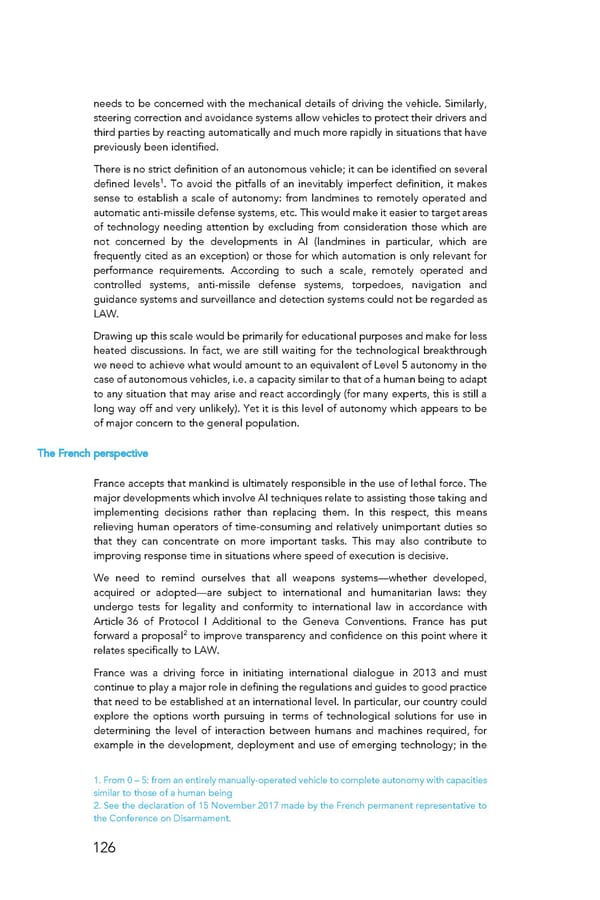needs to be concerned with the mechanical details of driving the vehicle. Similarly, steering correction and avoidance systems allow vehicles to protect their drivers and third parties by reacting automatically and much more rapidly in situations that have previously been identified. There is no strict definition of an autonomous vehicle; it can be identified on several defined levels1. To avoid the pitfalls of an inevitably imperfect definition, it makes sense to establish a scale of autonomy: from landmines to remotely operated and automatic anti-missile defense systems, etc. This would make it easier to target areas of technology needing attention by excluding from consideration those which are not concerned by the developments in AI (landmines in particular, which are frequently cited as an exception) or those for which automation is only relevant for performance requirements. According to such a scale, remotely operated and controlled systems, anti-missile defense systems, torpedoes, navigation and guidance systems and surveillance and detection systems could not be regarded as LAW. Drawing up this scale would be primarily for educational purposes and make for less heated discussions. In fact, we are still waiting for the technological breakthrough we need to achieve what would amount to an equivalent of Level 5 autonomy in the case of autonomous vehicles, i.e. a capacity similar to that of a human being to adapt to any situation that may arise and react accordingly (for many experts, this is still a long way off and very unlikely). Yet it is this level of autonomy which appears to be of major concern to the general population. The French perspective France accepts that mankind is ultimately responsible in the use of lethal force. The major developments which involve AI techniques relate to assisting those taking and implementing decisions rather than replacing them. In this respect, this means relieving human operators of time-consuming and relatively unimportant duties so that they can concentrate on more important tasks. This may also contribute to improving response time in situations where speed of execution is decisive. We need to remind ourselves that all weapons systems—whether developed, acquired or adopted—are subject to international and humanitarian laws: they undergo tests for legality and conformity to international law in accordance with Article 36 of Protocol I Additional to the Geneva Conventions. France has put forward a proposal2 to improve transparency and confidence on this point where it relates specifically to LAW. France was a driving force in initiating international dialogue in 2013 and must continue to play a major role in defining the regulations and guides to good practice that need to be established at an international level. In particular, our country could explore the options worth pursuing in terms of technological solutions for use in determining the level of interaction between humans and machines required, for example in the development, deployment and use of emerging technology; in the 1. From 0 – 5: from an entirely manually-operated vehicle to complete autonomy with capacities similar to those of a human being 2. See the declaration of 15 November 2017 made by the French permanent representative to the Conference on Disarmament. 126
 For a Meaningful AI - Report Page 125 Page 127
For a Meaningful AI - Report Page 125 Page 127